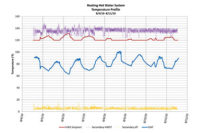In this column, I will describe the “issue” disclosed through analysis of the trend graph included in my April 2012 “Commissioning” column. I will also introduce a new system, show its trend graph, and then leave it up to the reader to discover the operational issue illustrated in the graph. The answer will be given at the start of next month’s column.
Last month’s trend graph showed about one week of 5-min interval data from the BAS for selected points in a central heating hot water boiler system. The system consisted of two high-efficiency modulating condensing hot water boilers with primary boiler pumps injecting hot water into a secondary variable flow distribution loop. These boilers were located in a northern climate where winter heating and summer reheat are both critical for maintaining space temperature and humidity criteria.APRIL 2012 TREND LOG ANALYSIS
The boiler staging and gas burner modulation was controlled by on-board manufacturer-provided controllers to maintain the secondary loop hot water supply temperature setpoint reset based on outside air temperature. The trend log was from summer operation when outdoor temperatures varied from about 60°F to 100°.
The most obvious information gleaned from the trend graph is the fact that the central boiler system appeared to be unable to modulate low enough to maintain the summertime temperature setpoints. Although the secondary supply water setpoint was varying with the outside air temperature (with a programmed minimum 120° value) as intended, the actual supply water temperature was about 10° to 15° higher than setpoint throughout the trend period. This appears to indicate that the boilers may have been inappropriately sized and that one of the boilers should have been smaller and capable of achieving summer temperature setpoints on its own.
A second interesting piece of information from the trend log is the fact that the secondary loop water temperature was continuously fluctuating about 5° to 10°. This seemed to imply that the boiler controller was modulating the burner control signal for some reason when it should have been modulating continuously at its minimum firing rate through a majority of the trend period. This raised the question of exactly how the boiler controller was programmed compared to what was documented.
Finally, the fact that the hot water temperature drop across the building was only about 5° during the trend period implied that the secondary loop was flowing more water than necessary. The system may have been a good candidate for an automatic differential pressure reset program to change the setpoint for the secondary pump VFDs based on the system control valve positions (i.e., based on system demand).
NEW SYSTEM
This month’s trend graph is of a rooftop air-handling system with hot water heating and chilled water cooling with full airside economizer capability. The system delivers air to variable volume reheat terminal units in a portion of a typical office building.
TRENDS
The discharge air temperature setpoint was 55° during the two week trend period in October, 2011. Although not included in the following graph, the outside air temperatures were cool and the rooftop unit was in economizer mode the entire time. The following data was collected at 2-min intervals and graphed below.
• Discharge air temperature (yellow)
• Mixed air temperature (green)
• Outside air damper control signal (blue)
• Chilled water valve control signal: 100% = fully open (pink)
• Hot water valve control signal: 100% = fully closed (red) ES





